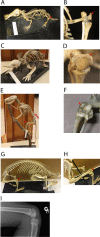Evolution of the patellar sesamoid bone in mammals
- PMID: 28344905
- PMCID: PMC5363259
- DOI: 10.7717/peerj.3103
Evolution of the patellar sesamoid bone in mammals
Abstract
The patella is a sesamoid bone located in the major extensor tendon of the knee joint, in the hindlimb of many tetrapods. Although numerous aspects of knee morphology are ancient and conserved among most tetrapods, the evolutionary occurrence of an ossified patella is highly variable. Among extant (crown clade) groups it is found in most birds, most lizards, the monotreme mammals and almost all placental mammals, but it is absent in most marsupial mammals as well as many reptiles. Here, we integrate data from the literature and first-hand studies of fossil and recent skeletal remains to reconstruct the evolution of the mammalian patella. We infer that bony patellae most likely evolved between four and six times in crown group Mammalia: in monotremes, in the extinct multituberculates, in one or more stem-mammal genera outside of therian or eutherian mammals and up to three times in therian mammals. Furthermore, an ossified patella was lost several times in mammals, not including those with absent hindlimbs: once or more in marsupials (with some re-acquisition) and at least once in bats. Our inferences about patellar evolution in mammals are reciprocally informed by the existence of several human genetic conditions in which the patella is either absent or severely reduced. Clearly, development of the patella is under close genomic control, although its responsiveness to its mechanical environment is also important (and perhaps variable among taxa). Where a bony patella is present it plays an important role in hindlimb function, especially in resisting gravity by providing an enhanced lever system for the knee joint. Yet the evolutionary origins, persistence and modifications of a patella in diverse groups with widely varying habits and habitats-from digging to running to aquatic, small or large body sizes, bipeds or quadrupeds-remain complex and perplexing, impeding a conclusive synthesis of form, function, development and genetics across mammalian evolution. This meta-analysis takes an initial step toward such a synthesis by collating available data and elucidating areas of promising future inquiry.
Keywords: Development; Genomics; Knee; Limb; Locomotion; Osteology; Paleontology; Pathology; Phylogeny; Theria.
Conflict of interest statement
John R. Hutchinson is an Academic Editor for PeerJ.
Figures







Similar articles
-
Evolution of the patella and patelloid in marsupial mammals.PeerJ. 2020 Aug 19;8:e9760. doi: 10.7717/peerj.9760. eCollection 2020. PeerJ. 2020. PMID: 32879804 Free PMC article.
-
Structure, ontogeny and evolution of the patellar tendon in emus (Dromaius novaehollandiae) and other palaeognath birds.PeerJ. 2014 Dec 23;2:e711. doi: 10.7717/peerj.711. eCollection 2014. PeerJ. 2014. PMID: 25551026 Free PMC article.
-
Anatomy, morphology and evolution of the patella in squamate lizards and tuatara (Sphenodon punctatus).J Anat. 2016 May;228(5):864-76. doi: 10.1111/joa.12435. Epub 2016 Jan 6. J Anat. 2016. PMID: 26740056 Free PMC article.
-
Ecophysiological steps of marine adaptation in extant and extinct non-avian tetrapods.Biol Rev Camb Philos Soc. 2021 Oct;96(5):1769-1798. doi: 10.1111/brv.12724. Epub 2021 Apr 26. Biol Rev Camb Philos Soc. 2021. PMID: 33904243 Review.
-
The locomotion of extinct secondarily aquatic tetrapods.Biol Rev Camb Philos Soc. 2022 Feb;97(1):67-98. doi: 10.1111/brv.12790. Epub 2021 Sep 6. Biol Rev Camb Philos Soc. 2022. PMID: 34486794 Review.
Cited by
-
Towards a Dynamic Model of the Kangaroo Knee for Clinical Insights into Human Knee Pathology and Treatment: Establishing a Static Biomechanical Profile.Biomimetics (Basel). 2019 Jul 25;4(3):52. doi: 10.3390/biomimetics4030052. Biomimetics (Basel). 2019. PMID: 31349696 Free PMC article.
-
Gearing effects of the patella (knee extensor muscle sesamoid) of the helmeted guineafowl during terrestrial locomotion.J Zool (1987). 2017 Nov;303(3):178-187. doi: 10.1111/jzo.12485. Epub 2017 Jul 19. J Zool (1987). 2017. PMID: 29200662 Free PMC article.
-
Genetics of the patella.Eur J Hum Genet. 2019 May;27(5):671-680. doi: 10.1038/s41431-018-0329-6. Epub 2019 Jan 21. Eur J Hum Genet. 2019. PMID: 30664715 Free PMC article. Review.
-
An overview of the osseous palmar sesamoid in Anura, with the particular case of some Rhinella species.PeerJ. 2023 May 15;11:e15063. doi: 10.7717/peerj.15063. eCollection 2023. PeerJ. 2023. PMID: 37214098 Free PMC article. Review.
-
Deciphering the influence of evolutionary legacy and functional constraints on the patella: an example in modern rhinoceroses amongst perissodactyls.PeerJ. 2024 Oct 25;12:e18067. doi: 10.7717/peerj.18067. eCollection 2024. PeerJ. 2024. PMID: 39469593 Free PMC article.
References
-
- Adams RA, Thibault KM. Ontogeny and evolution of the hindlimb and calcar: assessing phylogenetic trends. In: Adams RA, Pedersen SC, editors. Ontogeny, Functional Ecology, and Evolution of Bats. Cambridge: Cambridge University Press; 2000.
-
- Aglietti P, Menchetti PPM. Biomechanics of the patellofemoral joint. In: Scuderi GR, editor. The Patella. New York: Springer; 1995.
-
- Alexander RM, Dimery NJ. The significance of sesamoids and retro-articular processes for the mechanics of joints. Journal of Zoology. 1985;205(3):357–371. doi: 10.1111/j.1469-7998.1985.tb05622.x. - DOI
-
- Andrews SM, Westoll TS. The postcranial skeleton of Ensthenopteron foordi whiteaves. Earth and Environmental Science Transactions of the Royal Society of Edinburgh. 1970;68(9):207–329. doi: 10.1017/s008045680001471x. - DOI
LinkOut - more resources
Full Text Sources
Other Literature Sources

